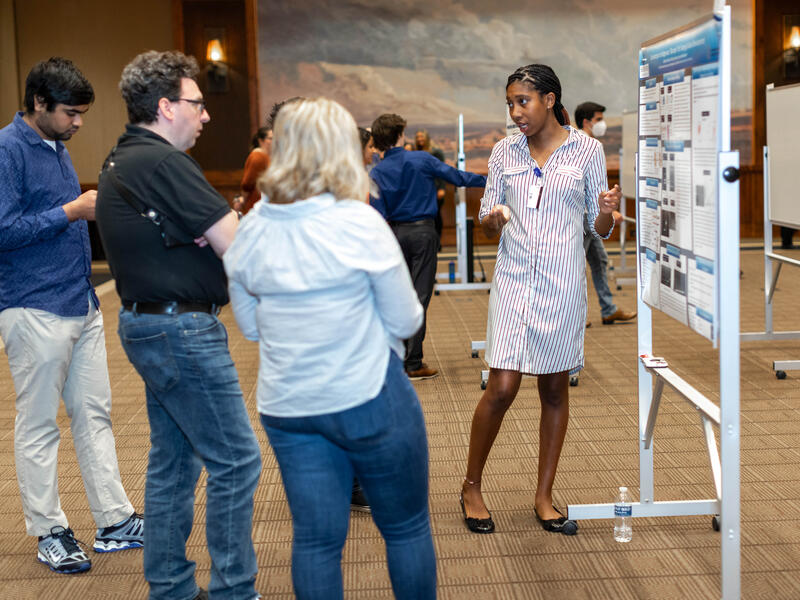The Sanford Program for Undergraduate Research (SPUR) was started in 2010 as an opportunity for students to gain research experience and preparation for a scientific career.
It has since become a great way to enhance diversity within Sanford Health’s workforce and introduce research as a career possibility to students who otherwise might not have access to these types of opportunities.
SPUR is part of a concerted effort by Sanford to take science and the research experience to the people it serves. Programs are available to students K-12, graduate students and the community, in addition to undergraduates.
For students and teachers: Explore STEM outreach at Sanford Research
Lance Lee, Ph.D., is Sanford Research’s director of higher education and has been part of SPUR’s efforts to make careers in research more accessible for more than a decade.
“A major part of what we do is recruiting students from underrepresented backgrounds,” Dr. Lee said. “That includes underrepresented students of color, students with disabilities, students from low-income backgrounds, first-generation college students and veterans in the armed services. There are many areas where there are students who are underrepresented in the sciences. In many cases, they’re representing small colleges where there aren’t a lot of research opportunities.”
The undergraduate program is partially funded by grants from the National Science Foundation and National Institutes of Health. Both, like Sanford Research, have designated diversity as a major mission. Building on that mission includes a network involving undergraduate, graduate and Ph.D. students.
Students to career research scientists
Ultimately, this comprehensive approach creates a pipeline that can lead to a career.
“One of our goals is to see students come through at multiple stages,” Dr. Lee said. “We want students who have been involved in the Sanford Program for Undergraduate Research to come back as graduate students in Ph.D. programs. We want them to recognize Sanford Research is a good fit for them for career success, wherever they end up going or whatever career path they end up choosing.”
Making it a good fit means making sure students have the resources they need to succeed. This includes providing a platform for meeting academic and professional goals that includes but is not restricted to the research lab.
“We offer professional development programming that helps students identify possible career paths they may be excited about and helps students seek them out,” Dr. Lee said. “We want to provide professional programming that helps them build skills — things like communication, writing and presentation — that they are going to need in their careers.”
SPUR has attracted applicants from all 50 states, Puerto Rico and several other countries since it began in 2010. Its alumni have gone on to graduate and enroll in doctoral programs all over the country.
“All research institutions need to step up and make a difference,” Dr. Lee said. “Sanford Research is definitely committed to doing that. We’re opening up opportunities for someone who could be the next Nobel Laureate. You can’t do that without access to opportunities in research.”
Setting graduates up for success
Shantelia Shook is a 2021 SPUR program graduate.
She said the experience was invaluable for a number of reasons:
- She gained hands-on experience which helped her solidify the pursuit of a career in research.
- She networked with some of the brightest minds in medicine and continues to talk with them to this day.
- The program set her up for success in multiple areas of her life.
Let’s take a look at that last bullet point.
Shook now works as a post-baccalaureate at Tufts University’s graduate school of biomedical sciences, in Boston, Massachusetts. Working in this program and university is very competitive, and Shook said she felt the SPUR program gave her a big leg up on the competition.
“The fact that I did the program and chose what I learned in the program as my senior project was very helpful in the interview process, because I got to say I’ve firsthand troubleshooted a project for six to eight months, trying to figure out if the experience would work. That gave me a lot of talking points during my interviews.
“That definitely helped me get in, because I felt like I was ready to do the program. So, it was really, really great,” she said.
Shook will be going to Duke University this summer for her Ph.D. in developmental and stem cell biology.
Learn more
- Simulation gives students glimpse into health care careers
- Hands-on program helps student live out research goal
- Childhood disease gains a new investigator
…
Posted In Inclusion at Sanford, Research, Undergrad College Resources
